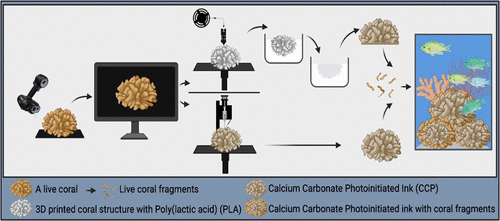当前位置:
X-MOL 学术
›
ACS Sustain. Chem. Eng.
›
论文详情
Our official English website, www.x-mol.net, welcomes your
feedback! (Note: you will need to create a separate account there.)
Sustainable and Eco-Friendly Coral Restoration through 3D Printing and Fabrication
ACS Sustainable Chemistry & Engineering ( IF 7.1 ) Pub Date : 2021-09-02 , DOI: 10.1021/acssuschemeng.1c04148 Hamed I. Albalawi 1 , Zainab N. Khan 1 , Alexander U. Valle-Pérez 1 , Kowther M. Kahin 1 , Maria Hountondji 1 , Hibatallah Alwazani 1 , Sebastian Schmidt-Roach 2 , Panayiotis Bilalis 1 , Manuel Aranda 2 , Carlos M. Duarte 2, 3 , Charlotte A. E. Hauser 1, 3
ACS Sustainable Chemistry & Engineering ( IF 7.1 ) Pub Date : 2021-09-02 , DOI: 10.1021/acssuschemeng.1c04148 Hamed I. Albalawi 1 , Zainab N. Khan 1 , Alexander U. Valle-Pérez 1 , Kowther M. Kahin 1 , Maria Hountondji 1 , Hibatallah Alwazani 1 , Sebastian Schmidt-Roach 2 , Panayiotis Bilalis 1 , Manuel Aranda 2 , Carlos M. Duarte 2, 3 , Charlotte A. E. Hauser 1, 3
Affiliation

|
Coral reef degradation is a rising problem, driven by marine heatwaves, the spread of coral diseases, and human impact by overfishing and pollution. Our capacity to restore coral reefs lags behind in terms of scale, effectiveness, and cost-efficiency. While common restoration efforts rely on the formation of carbonate skeletons on structural frames for supported coral growth, this technique is a rate-limiting step in the growth of scleractinian corals. Reverse engineering and additive manufacturing technologies offer an innovative shift in approach from the use of concrete blocks and metal frames to sophisticated efforts that use scanned geometries of harvested corals to fabricate artificial coral skeletons for installation in coral gardens and reefs. Herein, we present an eco-friendly and sustainable approach for coral fabrication by merging three-dimensional (3D) scanning, 3D printing, and molding techniques. Our method, 3D CoraPrint, exploits the 3D printing technology to fabricate artificial natural-based coral skeletons, expediting the growth rate of live coral fragments and quickening the reef transplantation process while minimizing nursery costs. It allows for flexibility, customization, and fast return time with an enhanced level of accuracy, thus establishing an environmentally friendly, scalable model for coral fabrication to boost restorative efforts around the globe.
中文翻译:

通过 3D 打印和制造进行可持续和生态友好的珊瑚修复
珊瑚礁退化是一个日益严重的问题,其原因是海洋热浪、珊瑚疾病的传播以及过度捕捞和污染对人类的影响。我们恢复珊瑚礁的能力在规模、有效性和成本效益方面都落后。虽然常见的修复工作依赖于在结构框架上形成碳酸盐骨架以支持珊瑚生长,但这种技术是石珊瑚生长的限速步骤。逆向工程和增材制造技术提供了一种创新的方法转变,从使用混凝土块和金属框架到使用采集的珊瑚的扫描几何形状来制造人造珊瑚骨架以安装在珊瑚花园和珊瑚礁中的复杂工作。在此处,我们通过融合三维 (3D) 扫描、3D 打印和成型技术,为珊瑚制造提供了一种环保且可持续的方法。我们的方法 3D CoraPrint 利用 3D 打印技术制造人造天然珊瑚骨架,加快活珊瑚碎片的生长速度,加快珊瑚礁移植过程,同时最大限度地降低苗圃成本。它允许灵活、定制和快速返回时间,并具有更高的准确性,从而为珊瑚制造建立一个环保、可扩展的模型,以促进全球的恢复工作。加快活珊瑚碎片的生长速度,加快珊瑚礁移植过程,同时最大限度地降低苗圃成本。它允许灵活、定制和快速返回时间,并具有更高的准确性,从而为珊瑚制造建立一个环保、可扩展的模型,以促进全球的恢复工作。加快活珊瑚碎片的生长速度,加快珊瑚礁移植过程,同时最大限度地降低苗圃成本。它允许灵活、定制和快速返回时间,并具有更高的准确性,从而为珊瑚制造建立一个环保、可扩展的模型,以促进全球的恢复工作。
更新日期:2021-09-20
中文翻译:

通过 3D 打印和制造进行可持续和生态友好的珊瑚修复
珊瑚礁退化是一个日益严重的问题,其原因是海洋热浪、珊瑚疾病的传播以及过度捕捞和污染对人类的影响。我们恢复珊瑚礁的能力在规模、有效性和成本效益方面都落后。虽然常见的修复工作依赖于在结构框架上形成碳酸盐骨架以支持珊瑚生长,但这种技术是石珊瑚生长的限速步骤。逆向工程和增材制造技术提供了一种创新的方法转变,从使用混凝土块和金属框架到使用采集的珊瑚的扫描几何形状来制造人造珊瑚骨架以安装在珊瑚花园和珊瑚礁中的复杂工作。在此处,我们通过融合三维 (3D) 扫描、3D 打印和成型技术,为珊瑚制造提供了一种环保且可持续的方法。我们的方法 3D CoraPrint 利用 3D 打印技术制造人造天然珊瑚骨架,加快活珊瑚碎片的生长速度,加快珊瑚礁移植过程,同时最大限度地降低苗圃成本。它允许灵活、定制和快速返回时间,并具有更高的准确性,从而为珊瑚制造建立一个环保、可扩展的模型,以促进全球的恢复工作。加快活珊瑚碎片的生长速度,加快珊瑚礁移植过程,同时最大限度地降低苗圃成本。它允许灵活、定制和快速返回时间,并具有更高的准确性,从而为珊瑚制造建立一个环保、可扩展的模型,以促进全球的恢复工作。加快活珊瑚碎片的生长速度,加快珊瑚礁移植过程,同时最大限度地降低苗圃成本。它允许灵活、定制和快速返回时间,并具有更高的准确性,从而为珊瑚制造建立一个环保、可扩展的模型,以促进全球的恢复工作。











































 京公网安备 11010802027423号
京公网安备 11010802027423号